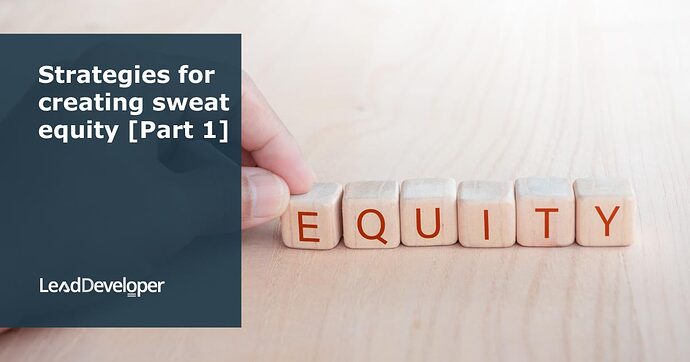Strategies for Creating Sweat Equity - 1
In this video, the speaker delves into various strategies for generating sweat equity without requiring a monetary investment, emphasizing the course’s comprehensive nature in covering all aspects necessary to become a successful no-money-down deal maker. The focus is on adding value and generating fees through several avenues:
Project Procurement Fee
Suggests earning through project procurement or spotters fees by identifying and stacking deals that are financially viable.
Financial Feasibility Fee
- Charging for conducting financial feasibility studies for others, utilizing specific financial software.
- Development Management Fee: Managing the development process, including due diligence, concept development, and engagement with consultants, among others.
Marketing or Leasing Fee
Offering marketing services for properties, which could extend to managing sales directly.
Property Management Fee
Taking on the role of a property manager post-development for a fee.
Insights based on numbers
- Financial feasibility services can command fees ranging from $1,100 to $1,500.
- Procurement or spotters fees are negotiable but can range anywhere from $5,000 to $15,000, depending on the deal’s size and the development margin involved.
- Development management fees can be either a fixed fee (e.g., $10,000 per townhouse) or a percentage of the project cost (1-7%), depending on the project size.
Frequently Asked Questions
How does one evaluate the financial viability of a no-money-down deal?
The video emphasizes the importance of “stacking” deals to evaluate their financial viability. Stacking involves conducting thorough due diligence and using financial feasibility software to crunch the numbers. By creating a comprehensive project report, you can determine if a project is financially viable. This process includes assessing development margins and ensuring the deal meets specific investment criteria. Developers, builders, and investors are willing to pay for this expertise, recognizing the value of well-analyzed, viable projects that can yield significant returns without initial capital investment.
What criteria must a deal meet to be considered for a spotters fee?
The video outlines that for a deal to be considered for a spotters fee, it must primarily demonstrate a significant development margin, ideally around 20%. The deal should be well-researched and stacked, meaning it has undergone thorough financial viability assessment to ensure it meets specific criteria sought by investors or developers. These criteria include not just profitability but also feasibility and alignment with the strategic interests of the potential buyer. The presenter suggests that such deals, if well-prepared and meeting these criteria, can command a spotters fee ranging from $5,000 to $15,000, depending on the deal’s size and complexity.
In what ways can a developer manage a project without being directly involved in construction?
The video distinguishes between the roles of a development manager and a project manager, highlighting that one can manage development projects without direct involvement in construction. The development manager focuses on the broader aspects of project development, including due diligence, concept development, business case development, financial structuring, and marketing. This role involves coordinating with builders, consultants, and managing the overall project strategy rather than the day-to-day construction activities.
Specifically, the development manager handles tasks like identifying suitable sites, conducting feasibility studies, managing financial risks, procuring legal documentation, and overseeing marketing and sales strategies. By leveraging expertise in these areas, a developer can effectively guide the project to completion, ensuring its success without needing to be an expert in construction. This approach allows for a more strategic management of the development process, focusing on financial and market feasibility, partnership management, and the successful execution of the project’s vision.
What is sweat equity?
Sweat equity refers to the value added to a project or a company through the effort and hard work of an individual or team, rather than through financial investment. It involves contributing time, skills, and expertise to increase the value of a project without necessarily injecting monetary capital.
How can someone generate sweat equity without investing money?
Generating sweat equity without financial investment involves leveraging one’s expertise and skills in various aspects of real estate and project development. This can include activities such as project procurement, conducting financial feasibility studies, managing development processes, offering marketing or leasing services, and managing properties post-development.
What is a project procurement fee and how does it work?
A project procurement fee, also known as a spotter’s fee, is earned by identifying and assembling deals that are financially viable. This involves finding potential development projects, assessing their viability, and then presenting them to investors or developers. The fee is a form of compensation for the effort and expertise involved in spotting and securing these opportunities.
How can one earn from financial feasibility studies?
Earning from financial feasibility studies involves charging a fee for conducting in-depth analysis using specific financial software to determine the viability of a project. This service can command fees ranging from $1,100 to $1,500, depending on the complexity and scope of the study. It requires expertise in financial analysis and a thorough understanding of the real estate market.
What does a development management fee entail?
A development management fee is charged for overseeing the development process of a project. This includes tasks such as conducting due diligence, developing concepts, engaging with consultants, and managing the overall development timeline and activities. The fee can be a fixed amount or a percentage of the project cost, ranging from 1% to 7%, depending on the size and complexity of the project.
How can marketing or leasing services generate fees?
Marketing or leasing services involve offering expertise in promoting properties, managing sales directly, or leasing activities. This can include creating marketing materials, conducting market research, and engaging with potential buyers or tenants. The fees for these services can vary based on the scope of work and the value added to the project.
What is involved in earning a property management fee?
Earning a property management fee involves taking on the role of a property manager after a project’s development. This includes overseeing the day-to-day operations of the property, managing tenants, and ensuring the property is well-maintained. The fee is compensation for the ongoing management and operational expertise provided.
How are fees for these services determined?
Fees for services such as project procurement, financial feasibility studies, development management, marketing or leasing, and property management are determined based on the value added, the complexity of the task, and the size of the project. These fees can be fixed amounts or percentages of project costs and are often negotiable based on the involved parties’ agreement.
Why focus on generating sweat equity in real estate development?
Focusing on generating sweat equity in real estate development allows individuals to leverage their expertise and skills to add value to projects without the need for direct financial investment. This approach can enable deal makers to participate in real estate opportunities they might not have had the capital to invest in directly, thus broadening their potential for income and project involvement.
Test Your Knowledge
Multiple-Choice Questions on Strategies for Creating Sweat Equity
1. What is the primary goal of generating sweat equity in real estate development?
A) To increase physical labor on construction sites.
B) To leverage expertise and skills to add value without financial investment.
C) To invest large sums of money for quick returns.
D) To buy and sell real estate properties rapidly.
2. How can sweat equity be generated through project procurement?
A) By offering free consultancy services.
B) By identifying and assembling financially viable deals.
C) By investing money into promising real estate projects.
D) By conducting public auctions for real estate properties.
3. What is involved in earning a financial feasibility fee?
A) Providing general financial advice to clients.
B) Conducting in-depth market research using generic tools.
C) Charging for conducting financial feasibility studies using specific financial software.
D) Investing in financial markets on behalf of real estate projects.
4. Which of the following best describes the method of earning a development management fee?
A) Charging a flat rate for any size of project.
B) Managing the development process, including tasks such as due diligence and concept development.
C) Solely focusing on the construction aspect of development.
D) Providing legal advice on property laws and regulations.
5. In the context of marketing or leasing fees, what services might be offered to generate sweat equity?
A) Only providing basic advertising services.
B) Offering marketing services that could extend to managing sales directly.
C) Limiting services to digital marketing strategies.
D) Focusing exclusively on property leasing with no involvement in sales.
6. What is a key activity in earning a property management fee?
A) Investing in property upgrades and renovations.
B) Taking on the role of a property manager post-development.
C) Conducting one-off property inspections.
D) Providing short-term property rental services.
7. How are procurement or spotter’s fees structured?
A) Based on a fixed percentage irrelevant of the deal’s size.
B) As a flat fee regardless of the project’s complexity.
C) Negotiable and can range depending on the deal’s size and development margin.
D) Solely based on the time spent identifying potential deals.
8. Which statement accurately reflects the payment structure for development management fees?
A) Always a fixed percentage of the total investment.
B) A fixed fee or a percentage of the project cost, depending on the project size.
C) A standard rate applied across all projects.
D) Determined by the local government regulations on real estate development.
Answers:
- B) To leverage expertise and skills to add value without financial investment.
- B) By identifying and assembling financially viable deals.
- C) Charging for conducting financial feasibility studies using specific financial software.
- B) Managing the development process, including tasks such as due diligence and concept development.
- B) Offering marketing services that could extend to managing sales directly.
- B) Taking on the role of a property manager post-development.
- C) Negotiable and can range depending on the deal’s size and development margin.
- B) A fixed fee or a percentage of the project cost, depending on the project size.
Assignment
Creating Sweat Equity in Real Estate
Objective:
This assignment is designed to deepen your understanding of generating sweat equity in real estate development without requiring a monetary investment. By completing this assignment, you will demonstrate your ability to apply the concepts of deal procurement, financial feasibility analysis, development management, marketing, and property management in practical scenarios.
Instructions:
Complete the following tasks and answer the questions below. Use online resources, financial software (if available), and real estate market analysis tools to assist you in completing this assignment. You may choose a hypothetical real estate project for the purpose of this assignment or analyze an existing project with publicly available information.
Tasks:
Project Procurement Analysis:
Identify a potential real estate development project in your area or a hypothetical one.
Write a brief report on how you would go about procuring this project, including identifying potential investors or developers, and the types of fees you would negotiate for procuring the deal.
Financial Feasibility Study:
Conduct a basic financial feasibility study of the project identified in Task 1.
Outline the key financial indicators you would analyze (e.g., ROI, IRR, NPV) and any specific software or tools you would use.
Estimate a reasonable range for the financial feasibility service fee you would charge based on the project’s complexity.
Development Management Proposal:
Create a proposal for managing the development process of your chosen project.
Include key phases of development management (e.g., due diligence, concept development, consultant engagement), and how you would charge for your services (fixed fee vs. percentage of the project cost).
Marketing and Leasing Plan:
Develop a marketing and leasing plan for the project.
Describe the marketing strategies you would employ and how you would manage sales or leasing directly.
Propose a fee structure for your marketing and leasing services.
Property Management Strategy:
Outline a strategy for managing the property post-development.
Discuss the services you would offer and how you would charge for your property management services.
Research Questions:
Market Analysis:
Research and document current trends in the real estate market in your area or the area of your hypothetical project. How do these trends affect your strategies for generating sweat equity?
Software and Tools:
Identify and evaluate at least two types of financial analysis software that could be used for conducting financial feasibility studies. Discuss the pros and cons of each.
Legal and Ethical Considerations:
Investigate and summarize the legal and ethical considerations involved in real estate development, particularly in relation to deal procurement and development management.
Deliverables:
Compile your findings, analyses, and strategies into a comprehensive report. Include all tasks and answers to the research questions.
Your report should be structured with clear headings for each section, and include charts, tables, or diagrams where appropriate to illustrate your strategies or analyses.
Include a conclusion that reflects on the overall feasibility and potential success of generating sweat equity in your chosen or hypothetical project based on your analyses.
Submission:
- Submit your report via mail or comments.
- Ensure that your report is well-organized, clearly written, and demonstrates a deep understanding of the concepts covered in the assignment.

![Strategies for creating sweat equity [Part 1]](https://edge.leaddeveloper.com/uploads/db5494/original/2X/2/2c500fa93862843f79ef3b21dc6410f0ad1b5c33.jpeg)

